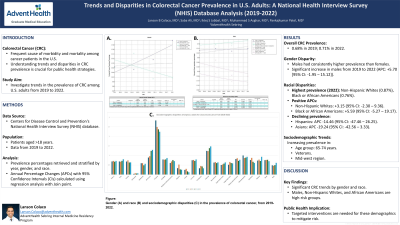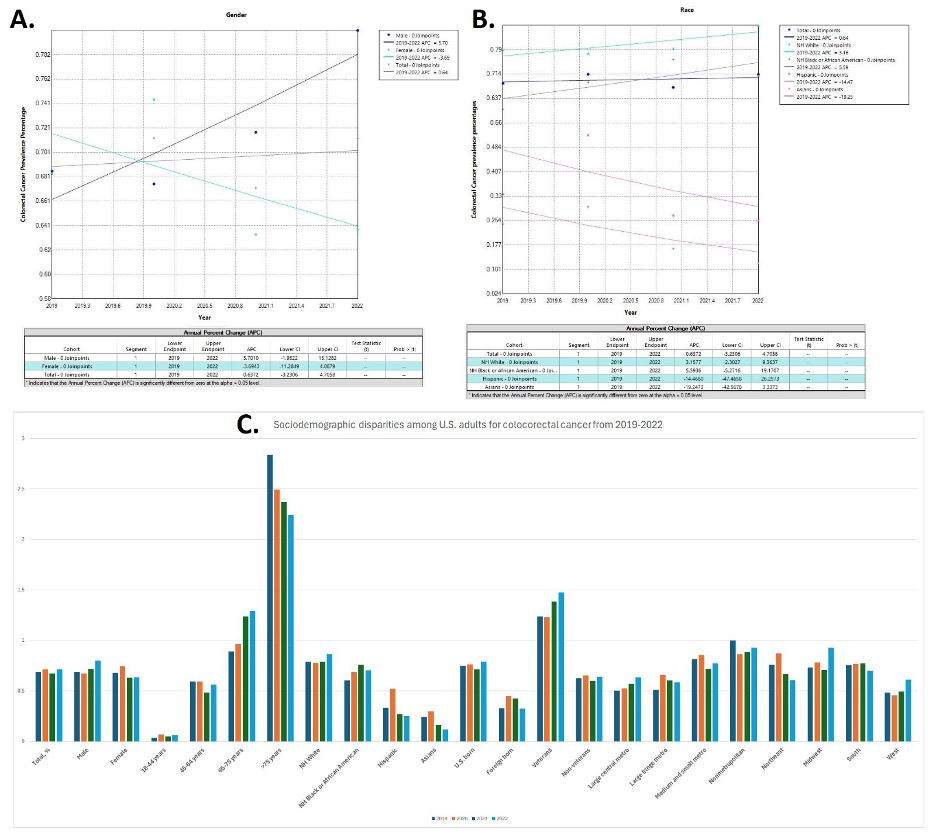Sunday Poster Session
Category: Colon
P0245 - Trends and Disparities in Colorectal Cancer Prevalence in U.S. Adults: A National Health Interview Survey Database Analysis (2019-2022)
Sunday, October 27, 2024
3:30 PM - 7:00 PM ET
Location: Exhibit Hall E


Lanson Brijesh B. Colaco, MD
AdventHealth
Sebring, FL
Presenting Author(s)
Lanson Brijesh Colaco, MD1, Iktej Jabbal, MD1, Muhammad Sohaib Asghar, MD1, Saba Ali, MD2, Rohin Patel, 3, Pankajkumar Patel, MD1
1AdventHealth, Sebring, FL; 2K.V.G. Medical College, Sullia, India, Sebring, FL; 3Columbia University, Sebring, FL
Introduction: Colorectal cancer (CRC) is the second leading cause of cancer-related mortality in the United States, ranking as the third leading cause of cancer deaths in men and the fourth in women. Understanding trends and potential disparities in the prevalence of this malignancy is critical for developing effective public health strategies. The aim of our study was to investigate the trends in the prevalence of CRC among adults in the United States from 2019 to 2022.
Methods: The National Health Interview Survey (NHIS) database, maintained by the Centers for Disease Control and Prevention (CDC), was queried to analyze the prevalence of CRC in patients aged over 18 from 2019 to 2022. Annual Percentage Changes (APCs) and their corresponding 95% confidence intervals (CIs) were calculated using regression analysis with Joinpoint analysis. The data were further stratified by year, gender, and race to evaluate trends within these specific subgroups.
Results: Between 2019 and 2022, the prevalence of CRC remained relatively stable, at 0.68% in 2019 and 0.71% in 2022. Males consistently exhibited a higher prevalence, with a significant increase from 2019 to 2022 [APC]: +5.70, 95% Confidence Interval [CI]: -1.95 to 15.12. Non-Hispanic Whites (NHW) and Black or African Americans (AA) demonstrated the highest prevalence rates, with NHW at 0.87% in 2022 and AA at 0.76% in 2021, both showing positive APCs (NHW: +3.15, 95% CI: -2.30 to 9.36; AA: +5.59, 95% CI: -5.27 to 19.17). Conversely, a downward trend in prevalence was observed among Hispanics (APC: -14.46, 95% CI: -47.46 to 26.25) and Asians (APC: -19.24, 95% CI: -42.56 to 3.33).
Discussion: Our study analyzed CRC prevalence trends revealing stable overall rates yet significant variations among demographic groups. Males exhibited a notable increase in CRC prevalence, while NHW and AA consistently showed higher prevalence rates. In contrast, Hispanics and Asians demonstrated decreasing trends in CRC prevalence over the study period. These findings emphasize the importance of tailored interventions for high-risk populations, including males and specific racial groups, to address disparities in CRC prevention and control effectively.

Disclosures:
Lanson Brijesh Colaco, MD1, Iktej Jabbal, MD1, Muhammad Sohaib Asghar, MD1, Saba Ali, MD2, Rohin Patel, 3, Pankajkumar Patel, MD1. P0245 - Trends and Disparities in Colorectal Cancer Prevalence in U.S. Adults: A National Health Interview Survey Database Analysis (2019-2022), ACG 2024 Annual Scientific Meeting Abstracts. Philadelphia, PA: American College of Gastroenterology.
1AdventHealth, Sebring, FL; 2K.V.G. Medical College, Sullia, India, Sebring, FL; 3Columbia University, Sebring, FL
Introduction: Colorectal cancer (CRC) is the second leading cause of cancer-related mortality in the United States, ranking as the third leading cause of cancer deaths in men and the fourth in women. Understanding trends and potential disparities in the prevalence of this malignancy is critical for developing effective public health strategies. The aim of our study was to investigate the trends in the prevalence of CRC among adults in the United States from 2019 to 2022.
Methods: The National Health Interview Survey (NHIS) database, maintained by the Centers for Disease Control and Prevention (CDC), was queried to analyze the prevalence of CRC in patients aged over 18 from 2019 to 2022. Annual Percentage Changes (APCs) and their corresponding 95% confidence intervals (CIs) were calculated using regression analysis with Joinpoint analysis. The data were further stratified by year, gender, and race to evaluate trends within these specific subgroups.
Results: Between 2019 and 2022, the prevalence of CRC remained relatively stable, at 0.68% in 2019 and 0.71% in 2022. Males consistently exhibited a higher prevalence, with a significant increase from 2019 to 2022 [APC]: +5.70, 95% Confidence Interval [CI]: -1.95 to 15.12. Non-Hispanic Whites (NHW) and Black or African Americans (AA) demonstrated the highest prevalence rates, with NHW at 0.87% in 2022 and AA at 0.76% in 2021, both showing positive APCs (NHW: +3.15, 95% CI: -2.30 to 9.36; AA: +5.59, 95% CI: -5.27 to 19.17). Conversely, a downward trend in prevalence was observed among Hispanics (APC: -14.46, 95% CI: -47.46 to 26.25) and Asians (APC: -19.24, 95% CI: -42.56 to 3.33).
Discussion: Our study analyzed CRC prevalence trends revealing stable overall rates yet significant variations among demographic groups. Males exhibited a notable increase in CRC prevalence, while NHW and AA consistently showed higher prevalence rates. In contrast, Hispanics and Asians demonstrated decreasing trends in CRC prevalence over the study period. These findings emphasize the importance of tailored interventions for high-risk populations, including males and specific racial groups, to address disparities in CRC prevention and control effectively.

Figure: Figure 1. Gender (A) and race (B), and Sociodemographic disparities (C) in the prevalence of colorectal cancer, from 2019-2022.
Disclosures:
Lanson Brijesh Colaco indicated no relevant financial relationships.
Iktej Jabbal indicated no relevant financial relationships.
Muhammad Sohaib Asghar indicated no relevant financial relationships.
Saba Ali indicated no relevant financial relationships.
Rohin Patel indicated no relevant financial relationships.
Pankajkumar Patel indicated no relevant financial relationships.
Lanson Brijesh Colaco, MD1, Iktej Jabbal, MD1, Muhammad Sohaib Asghar, MD1, Saba Ali, MD2, Rohin Patel, 3, Pankajkumar Patel, MD1. P0245 - Trends and Disparities in Colorectal Cancer Prevalence in U.S. Adults: A National Health Interview Survey Database Analysis (2019-2022), ACG 2024 Annual Scientific Meeting Abstracts. Philadelphia, PA: American College of Gastroenterology.
